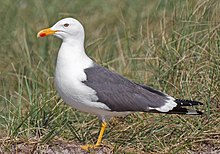Lesser black-backed gull
| Lesser black-backed gull | |
|---|---|
 |
|
| Larus fuscus graellsii with red and silver leg rings; England | |
| Scientific classification | |
| Kingdom: | Animalia |
| Phylum: | Chordata |
| Class: | Aves |
| Order: | Charadriiformes |
| Family: | Laridae |
| Genus: | Larus |
| Species: | L. fuscus |
| Binomial name | |
|
Larus fuscus Linnaeus, 1758 |
|
The lesser black-backed gull (Larus fuscus) is a large gull that breeds on the Atlantic coasts of Europe. The scientific name is from Latin. Larus appears to have referred to a gull or other large seabird, and fuscus meant black or brown.
It is migratory, wintering from the British Isles south to West Africa. It is a regular winter visitor to the east coast of North America, probably from the breeding population in Iceland.
This species breeds colonially on coasts and lakes, making a lined nest on the ground or a cliff. Normally, three eggs are laid. In some cities the species nests within the urban environment, often in association with herring gulls.
They are smaller than the herring gull. The taxonomy of the herring gull / lesser black-backed gull complex is very complicated; different authorities recognise between two and eight species. This group has a ring distribution around the northern hemisphere. Differences between adjacent forms in this ring are fairly small, but by the time the circuit is completed, the end members, herring gull and lesser black-backed gull, are clearly different species. The lesser black-backed gull measures 51–64 cm (20–25 in), 124–150 cm (49–59 in) across the wings and weighs 452–1,100 g (0.996–2.425 lb), with the nominate race averaging slightly smaller than the other two subspecies. Males, at average weight of 824 g (1.817 lb), are slightly larger than females, at an average of 708 g (1.561 lb). Among standard measurements, the wing chord is 38.3 to 45 cm (15.1 to 17.7 in), the bill is 4.2 to 5.8 cm (1.7 to 2.3 in) and the tarsus is 5.2 to 6.9 cm (2.0 to 2.7 in). A confusable species is the great black-backed gull. The lesser is a much smaller bird, with slimmer build, yellow rather than pinkish legs, and smaller white "mirrors" at the wing tips. The adults have black or dark grey wings (depending on race) and back. The bill is yellow with a red spot which young peck at, inducing feeding (see fixed action pattern). The head is greyer in winter, unlike great black-backed. Annual moult for adults begins between May and August and is not complete on some birds until November. Partial pre-breeding moult between January and April
...
Wikipedia

